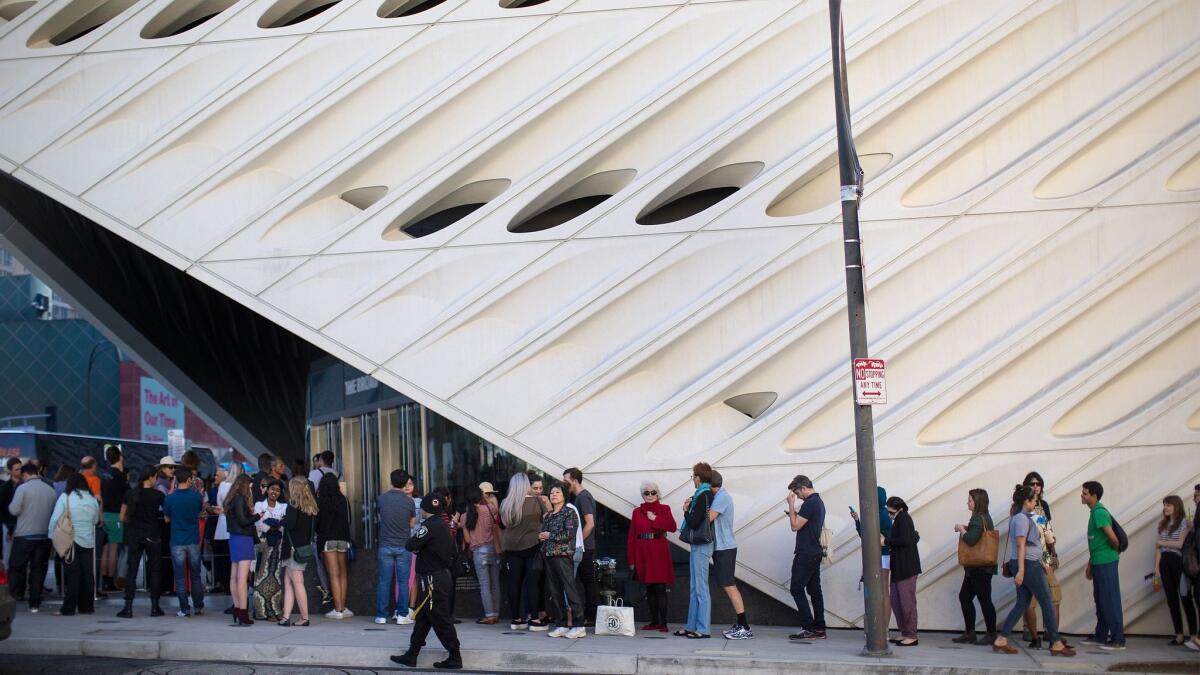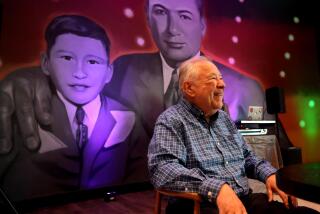The architecture of moviegoing: Can the multiplex stay in the picture?
- Share via
I read a lot of magazines, blogs and social-media feeds dedicated to architecture — more than I’d like to admit. None of them covered the news that Alejandro Iñárritu’s contribution to the Cannes Film Festival this year came in the form of a 6-minute experiment in virtual-reality filmmaking.
They probably should have.
“Carne y Arena,” a collaboration between Iñárritu and his longtime cinematographer, Emmanuel Lubezki, was described by my colleague Steven Zeitchik as “a multi-platform experience that includes a VR film; it is so sprawling the festival installed it in an airplane hangar 20 minutes outside downtown Cannes.” Viewers strapped on Oculus Rift headsets and then set out on foot to experience a 360-degree story set in the Arizona desert, along the U.S.-Mexico border.
What does this have to do with architecture? Everything.
As the courtship between Hollywood studios and virtual-reality start-ups intensifies, it’s pretty clear who is most anxious about being left off the guest list for the eventual wedding: the multiplex.
It’s telling that there wasn’t a suitable space among the traditional Cannes theaters to accommodate “Carne y Arena,” but advances in VR are hardly the only threat to the traditional architecture of moviegoing. Netflix and other streaming services have already landed serious blows. Smartphone owners now carry in their pockets a movie theater capable of showing not just new releases but nearly every movie ever made. This development is in its way as destabilizing to traditional notions of retail architecture, and even city-making, as the success of Amazon has been to brick and mortar bookstores.
Cannes offered a very public platform for these anxieties too. When audience members rained down boos on the Netflix-produced “Okja,” a film by the Korean director Bong Joon-ho that won’t have a theatrical release, they were making an architectural complaint as well as a cinematic one. They were arguing that in bypassing typical distribution channels the streaming company was shrinking not just the size of screens on which the film would be watched but the communal experience that has always been central to moviegoing.
And think about that word, “moviegoing.” (Or the title of Walker Percy’s 1961 novel, “The Moviegoer.”) The art form from its earliest days has been inherently architectural: to see a movie meant having a destination. The word cinema means filmmaking; it also means a building that shows movies.
The alliance looks shaky. Technology is breaking up that compound word, moviegoing, peeling the noun from the verb.

If I were a multiplex owner ... I’d be looking hard for examples where architecture and technology have managed to form ... symbiotic relationships.
— Christopher Hawthorne
Spanish director Pedro Almodovar, the head of this year’s Cannes competition jury, touched on that shift and the worries that come with it when he argued during the festival that a movie screen “should not be smaller than the chair on which you are sitting.” It was a curious place to draw that particular cultural line. So a TV at home is an acceptable alternative to the art house, but a phone, tablet or laptop is not?
And what if — as with “Carne y Arena” — there are no chairs at all? In that case the word “moviegoing” might be redefined or reanimated by VR. Watching a film may soon become an exercise in moving through a particular space, as opposed to the passive approach that is common to both multiplex and home viewing.
It’s possible that some forward-looking theater chain will respond to these shifts by brilliantly retrofitting the typical suburban movie house to accommodate VR screenings. It seems likelier that we’ll see the emergence of a new kind of gathering place for virtual-reality experiences that bypasses multiplex owners altogether.
In September Dreamscape Immersive, an L.A.-based start-up, will open what it’s calling a “VR Multiplex” inside the Westfield Mall in Century City. “The facility,” Variety reported, “will use un-tethered VR headsets to allow consumers to move freely through a space and interact with real and virtual objects as well as with each other.”
The company’s CEO, Bruce Vaughn, is a veteran of Walt Disney Imagineering. Its backers include Warner Bros., IMAX and Steven Spielberg. One member of its advisory board is the industrial designer Yves Behar, a name far more familiar in Silicon Valley than Hollywood.
Maybe this brave new cinematic world will be a flop, commercially or otherwise. Maybe it will take some shape we never anticipated. The survival skills of the printed book and the vinyl record suggest that certain aspects of the moviegoing experience may prove to have continuing appeal even, or maybe especially, in an otherwise digitized marketplace.
Still, if I were a multiplex owner, or anybody with a career that depends on precisely how the future of moviegoing shakes out, I’d be looking hard for examples where architecture and technology have managed to form successful and even symbiotic partnerships.
One comes from the art world, where new and old museums alike have begun to see smartphones and social media not just as a vehicle for free advertising but as increasingly central to how they define themselves as institutions. A standby line forms nearly every day outside the 2-year-old Broad museum, holding visitors waiting for same-day passes. These visitors, relying on the photogenic honeycomb skin of the museum as a backdrop, post a steady stream of images from this line to Instagram, underscoring the idea that the queue itself is an attraction — and the reputation of the museum as a sought-after destination. The line has its own Twitter feed: @TheBroadStandby.
Though this reliance on buzz understandably troubles art-world purists, it has also introduced a new generation of Angelenos to museum-going. (It helps that the museum is free.) The average age of Broad visitors is noticeably younger than at, say, the Museum of Contemporary Art across the street.
Another model (and perhaps a stronger one) is the work of the Industry, an experimental L.A. opera company whose ingenious productions require audience members to move through a sequence of different spaces. One show, “Invisible Cities,” took place in nearly every corner of Union Station. Another, “Hopscotch,” used a fleet of limousines to carry audience members and musicians alike to locations in and around downtown L.A.
The company uses high-tech tools (including wireless headsets and screens of many sizes) to turn landmarks into stage sets. Technology becomes not a distraction in these shows but precisely a means of heightening our attention to architectural detail. The company’s founder and artistic director, Yuval Sharon, is thinking about the relationship between audiences and technological change as inventively as anyone in Los Angeles.
There are risks in these examples when it comes to VR. The experience of using a headset like Oculus Rift is not just isolating, the way watching a movie on a smartphone or listening to music through a wireless headset can be. It is downright cocooning.
By now you’ve probably seen the photograph of Facebook founder Mark Zuckerberg strolling down the aisle at a European tech conference last year, passing a theater full of people wearing VR headsets as he made his way to the stage. The image has become a kind of shorthand for the pitfalls of a VR future in which our digital overlords can see and we all grow blind, even as we’re sure that our vision is being improved by the day.
It suggests that despite examples like the Broad, the connectivity seemingly provided by technology may be illusory. That the unit that matters when it comes to measuring the distance between us is not the inch but the pixel. That it’s entirely possible for us to be alone — atomized — together.
“Carne y Arena” will be mounted at the Los Angeles County Museum of Art next month. I’ll be curious to see how audiences react to it there. I’ll be even more curious to see how, and precisely where on the museum campus, Iñárritu and LACMA decide to stage it.
Special Report: Can moviegoing be saved? »
Twitter: @hawthornelat
ALSO:
Netflix’s first movie appears at Cannes, and so does the controversy
Alejandro Iñárritu’s virtual reality project takes film to new frontiers—and questions
Practically a film festival every night: The new ecology of the old-movie scene in L.A.
More to Read
The biggest entertainment stories
Get our big stories about Hollywood, film, television, music, arts, culture and more right in your inbox as soon as they publish.
You may occasionally receive promotional content from the Los Angeles Times.











